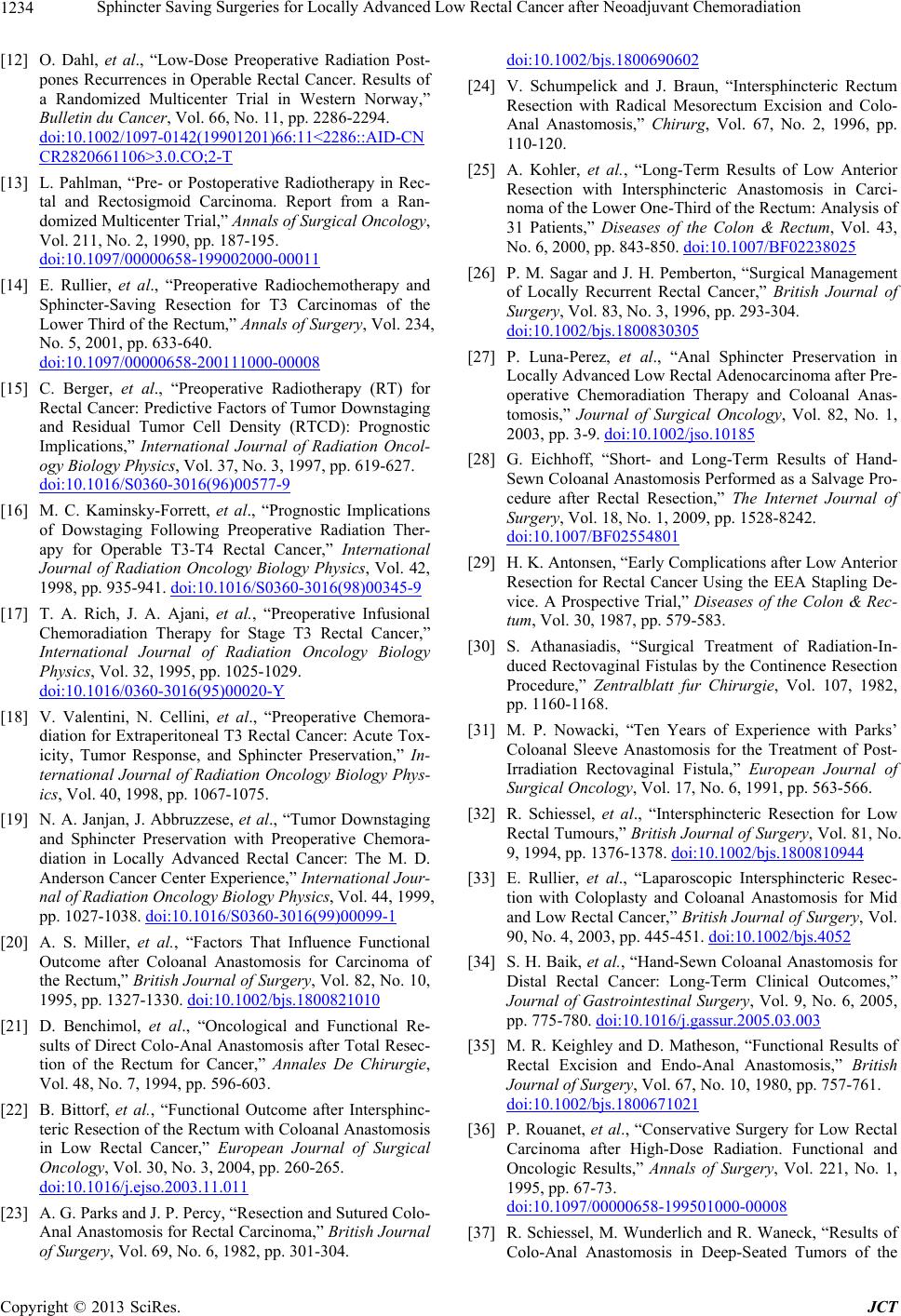
Sphincter Saving Surgeries for Locally Advanced Low Rectal Cancer after Neoadjuvant Chemoradiation
1234
[12] O. Dahl, et al., “Low-Dose Preoperative Radiation Post-
pones Recurrences in Operable Rectal Cancer. Results of
a Randomized Multicenter Trial in Western Norway,”
Bulletin du Cancer, Vol. 66, No. 11, pp. 2286-2294.
doi:10.1002/1097-0142(19901201)66:11<2286::AID-CN
CR2820661106>3.0.CO;2-T
[13] L. Pahlman, “Pre- or Postoperative Radiotherapy in Rec-
tal and Rectosigmoid Carcinoma. Report from a Ran-
domized Multicenter Trial,” Annals of Surgical Oncology,
Vol. 211, No. 2, 1990, pp. 187-195.
doi:10.1097/00000658-199002000-00011
[14] E. Rullier, et al., “Preoperative Radiochemotherapy and
Sphincter-Saving Resection for T3 Carcinomas of the
Lower Third of the Rectum,” Annals of Surgery, Vol. 234,
No. 5, 2001, pp. 633-640.
doi:10.1097/00000658-200111000-00008
[15] C. Berger, et al., “Preoperative Radiotherapy (RT) for
Rectal Cancer: Predictive Factors of Tumor Downstaging
and Residual Tumor Cell Density (RTCD): Prognostic
Implications,” International Journal of Radiation Oncol-
ogy Biology Physics, Vol. 37, No. 3, 1997, pp. 619-627.
doi:10.1016/S0360-3016(96)00577-9
[16] M. C. Kaminsky-Forrett, et al., “Prognostic Implications
of Dowstaging Following Preoperative Radiation Ther-
apy for Operable T3-T4 Rectal Cancer,” International
Journal of Radiation Oncology Biology Physics, Vol. 42,
1998, pp. 935-941. doi:10.1016/S0360-3016(98)00345-9
[17] T. A. Rich, J. A. Ajani, et al., “Preoperative Infusional
Chemoradiation Therapy for Stage T3 Rectal Cancer,”
International Journal of Radiation Oncology Biology
Physics, Vol. 32, 1995, pp. 1025-1029.
doi:10.1016/0360-3016(95)00020-Y
[18] V. Valentini, N. Cellini, et al., “Preoperative Chemora-
diation for Extraperitoneal T3 Rectal Cancer: Acute Tox-
icity, Tumor Response, and Sphincter Preservation,” In-
ternational Journal of Radiation Oncology Biology Phys-
ics, Vol. 40, 1998, pp. 1067-1075.
[19] N. A. Janjan, J. Abbruzzese, et al., “Tumor Downstaging
and Sphincter Preservation with Preoperative Chemora-
diation in Locally Advanced Rectal Cancer: The M. D.
Anderson Cancer Center Experience,” International Jour-
nal of Radiation Oncology Biology Physics, Vol. 44, 1999,
pp. 1027-1038. doi:10.1016/S0360-3016(99)00099-1
[20] A. S. Miller, et al., “Factors That Influence Functional
Outcome after Coloanal Anastomosis for Carcinoma of
the Rectum,” British Journal of Surgery, Vol. 82, No. 10,
1995, pp. 1327-1330. doi:10.1002/bjs.1800821010
[21] D. Benchimol, et al., “Oncological and Functional Re-
sults of Direct Colo-Anal Anastomosis after Total Resec-
tion of the Rectum for Cancer,” Annales De Chirurgie,
Vol. 48, No. 7, 1994, pp. 596-603.
[22] B. Bittorf, et al., “Functional Outcome after Intersphinc-
teric Resection of the Rectum with Coloanal Anastomosis
in Low Rectal Cancer,” European Journal of Surgical
Oncology, Vol. 30, No. 3, 2004, pp. 260-265.
doi:10.1016/j.ejso.2003.11.011
[23] A. G. Parks and J. P. Percy, “Resection and Sutured Colo-
Anal Anastomosis for Rectal Carcinoma,” British Journal
of Surgery, Vol. 69, No. 6, 1982, pp. 301-304.
doi:10.1002/bjs.1800690602
[24] V. Schumpelick and J. Braun, “Intersphincteric Rectum
Resection with Radical Mesorectum Excision and Colo-
Anal Anastomosis,” Chirurg, Vol. 67, No. 2, 1996, pp.
110-120.
[25] A. Kohler, et al., “Long-Term Results of Low Anterior
Resection with Intersphincteric Anastomosis in Carci-
noma of the Lower One-Third of the Rectum: Analysis of
31 Patients,” Diseases of the Colon & Rectum, Vol. 43,
No. 6, 2000, pp. 843-850. doi:10.1007/BF02238025
[26] P. M. Sagar and J. H. Pemberton, “Surgical Management
of Locally Recurrent Rectal Cancer,” British Journal of
Surgery, Vol. 83, No. 3, 1996, pp. 293-304.
doi:10.1002/bjs.1800830305
[27] P. Luna-Perez, et al., “Anal Sphincter Preservation in
Locally Advanced Low Rectal Adenocarcinoma after Pre-
operative Chemoradiation Therapy and Coloanal Anas-
tomosis,” Journal of Surgical Oncology, Vol. 82, No. 1,
2003, pp. 3-9. doi:10.1002/jso.10185
[28] G. Eichhoff, “Short- and Long-Term Results of Hand-
Sewn Coloanal Anastomosis Performed as a Salvage Pro-
cedure after Rectal Resection,” The Internet Journal of
Surgery, Vol. 18, No. 1, 2009, pp. 1528-8242.
doi:10.1007/BF02554801
[29] H. K. Antonsen, “Early Complications after Low Anterior
Resection for Rectal Cancer Using the EEA Stapling De-
vice. A Prospective Trial,” Diseases of the Colon & Rec-
tum, Vol. 30, 1987, pp. 579-583.
[30] S. Athanasiadis, “Surgical Treatment of Radiation-In-
duced Rectovaginal Fistulas by the Continence Resection
Procedure,” Zentralblatt fur Chirurgie, Vol. 107, 1982,
pp. 1160-1168.
[31] M. P. Nowacki, “Ten Years of Experience with Parks’
Coloanal Sleeve Anastomosis for the Treatment of Post-
Irradiation Rectovaginal Fistula,” European Journal of
Surgical Oncology, Vol. 17, No. 6, 1991, pp. 563-566.
[32] R. Schiessel, et al., “Intersphincteric Resection for Low
Rectal Tumours,” British Journal of Surgery, Vol. 81, No.
9, 1994, pp. 1376-1378. doi:10.1002/bjs.1800810944
[33] E. Rullier, et al., “Laparoscopic Intersphincteric Resec-
tion with Coloplasty and Coloanal Anastomosis for Mid
and Low Rectal Cancer,” British Journal of Surgery, Vol.
90, No. 4, 2003, pp. 445-451. doi:10.1002/bjs.4052
[34] S. H. Baik, et al., “Hand-Sewn Coloanal Anastomosis for
Distal Rectal Cancer: Long-Term Clinical Outcomes,”
Journal of Gastrointestinal Surgery, Vol. 9, No. 6, 2005,
pp. 775-780. doi:10.1016/j.gassur.2005.03.003
[35] M. R. Keighley and D. Matheson, “Functional Results of
Rectal Excision and Endo-Anal Anastomosis,” British
Journal of Surgery, Vol. 67, No. 10, 1980, pp. 757-761.
doi:10.1002/bjs.1800671021
[36] P. Rouanet, et al., “Conservative Surgery for Low Rectal
Carcinoma after High-Dose Radiation. Functional and
Oncologic Results,” Annals of Surgery, Vol. 221, No. 1,
1995, pp. 67-73.
doi:10.1097/00000658-199501000-00008
[37] R. Schiessel, M. Wunderlich and R. Waneck, “Results of
Colo-Anal Anastomosis in Deep-Seated Tumors of the
Copyright © 2013 SciRes. JCT